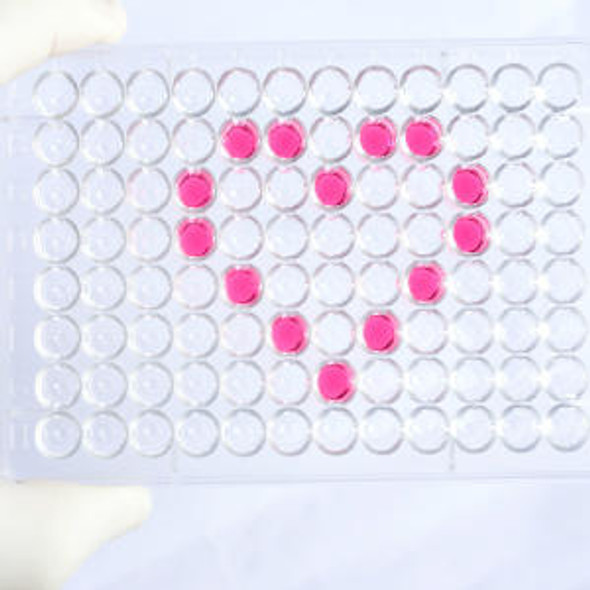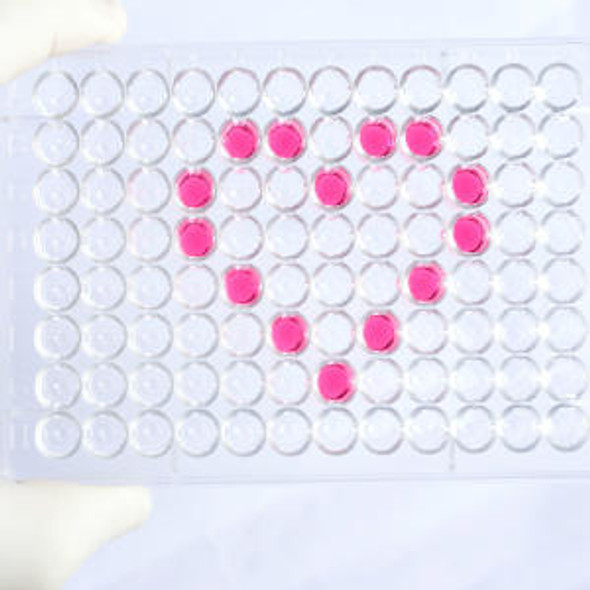Human CPR / Cytochrome P450 Reductase ELISA Kit
- SKU:
- HUFI02360
- Product Type:
- ELISA Kit
- Size:
- 96 Assays
- Uniprot:
- P16435
- Sensitivity:
- 0.094ng/ml
- Range:
- 0.156-10ng/ml
- ELISA Type:
- Sandwich
- Synonyms:
- CPR, CYPOR, Cytochrome P450 Reductase, P450R, EC 1.6.2.4, NADPH--cytochrome P450 reductase, NADPH-dependent cytochrome P450 reductase, P450, cytochrome oxidoreductase
- Reactivity:
- Human
- Research Area:
- Cell Biology
Description
Human CPR / Cytochrome P450 Reductase ELISA
POR (Cytochrome P450 Oxidoreductase) encodes an endoplasmic reticulum membrane oxidoreductase that is essential for multiple metabolic processes. POR inhibitors are a class of drugs used to treat cancer. Diseases associated with POR include Disordered Steroidogenesis Due To Cytochrome P450 Oxidoreductase Deficiency and Antley-Bixler Syndrome With Genital Anomalies And Disordered Steroidogenesis. An important paralog of POR is MTRR. The Assay Genie Human CPR / Cytochrome P450 Reductase ELISA is a highly sensitive assay for the quantitative measurement of CPR / Cytochrome P450 Reductase in serum, blood, plasma, cell culture supernatant and tissue samples.
| Product Name: | Human CPR / Cytochrome P450 Reductase ELISA Kit |
| Product Code: | HUFI02360 |
| Size: | 96 Assays |
| Alias: | CPR, CYPOR, Cytochrome P450 Reductase, P450R, EC 1.6.2.4, NADPH--cytochrome P450 reductase, NADPH-dependent cytochrome P450 reductase, P450, cytochrome oxidoreductase |
| Detection method: | Sandwich ELISA, Double Antibody |
| Application: | This immunoassay kit allows for the in vitro quantitative determination of Human CPR concentrations in serum plasma and other biological fluids. |
| Sensitivity: | 0.094ng/ml |
| Range: | 0.156-10ng/ml |
| Storage: | 4°C for 6 months |
| Note: | For Research Use Only |
| Recovery: | Matrices listed below were spiked with certain level of Human CPR and the recovery rates were calculated by comparing the measured value to the expected amount of Human CPR in samples. | ||||||||||||||||
| |||||||||||||||||
| Linearity: | The linearity of the kit was assayed by testing samples spiked with appropriate concentration of Human CPR and their serial dilutions. The results were demonstrated by the percentage of calculated concentration to the expected. | ||||||||||||||||
| |||||||||||||||||
| CV(%): | Intra-Assay: CV<8% Inter-Assay: CV<10% |
| Component | Quantity | Storage |
| ELISA Microplate (Dismountable) | 8×12 strips | 4°C for 6 months |
| Lyophilized Standard | 2 | 4°C/-20°C |
| Sample/Standard Dilution Buffer | 20ml | 4°C |
| Biotin-labeled Antibody(Concentrated) | 120ul | 4°C (Protect from light) |
| Antibody Dilution Buffer | 10ml | 4°C |
| HRP-Streptavidin Conjugate(SABC) | 120ul | 4°C (Protect from light) |
| SABC Dilution Buffer | 10ml | 4°C |
| TMB Substrate | 10ml | 4°C (Protect from light) |
| Stop Solution | 10ml | 4°C |
| Wash Buffer(25X) | 30ml | 4°C |
| Plate Sealer | 5 | - |
Other materials and equipment required:
- Microplate reader with 450 nm wavelength filter
- Multichannel Pipette, Pipette, microcentrifuge tubes and disposable pipette tips
- Incubator
- Deionized or distilled water
- Absorbent paper
- Buffer resevoir
| Uniprot | P16435 |
| UniProt Protein Function: | POR: This enzyme is required for electron transfer from NADP to cytochrome P450 in microsomes. It can also provide electron transfer to heme oxygenase and cytochrome B5. Defects in POR are the cause of Antley-Bixler syndrome with genital anomalies and disordered steroidogenesis (ABS1). A disease characterized by the association of Antley-Bixler syndrome with steroidogenesis defects and abnormal genitalia. Antley-Bixler syndrome is characterized by craniosynostosis, radiohumeral synostosis present from the perinatal period, midface hypoplasia, choanal stenosis or atresia, femoral bowing and multiple joint contractures. Defects in POR are the cause of disordered steroidogenesis due to cytochrome P450 oxidoreductase deficiency (DISPORD). A disorder resulting in a rare variant of congenital adrenal hyperplasia, with apparent combined P450C17 and P450C21 deficiency and accumulation of steroid metabolites. Affected girls are born with ambiguous genitalia, but their circulating androgens are low and virilization does not progress. Conversely, affected boys are sometimes born undermasculinized. Boys and girls can present with bone malformations, in some cases resembling the pattern seen in patients with Antley-Bixler syndrome. |
| UniProt Protein Details: | Protein type:EC 1.6.2.4; Endoplasmic reticulum; Mitochondrial; Oxidoreductase Chromosomal Location of Human Ortholog: 7q11.2 Cellular Component: endoplasmic reticulum membrane; intracellular membrane-bound organelle; membrane Molecular Function:[methionine synthase] reductase activity; NADPH-hemoprotein reductase activity; protein binding Biological Process: positive regulation of monooxygenase activity; xenobiotic metabolic process Disease: Antley-bixler Syndrome With Genital Anomalies And Disordered Steroidogenesis; Antley-bixler Syndrome Without Genital Anomalies Or Disordered Steroidogenesis; Disordered Steroidogenesis Due To Cytochrome P450 Oxidoreductase Deficiency |
| NCBI Summary: | This gene encodes an endoplasmic reticulum membrane oxidoreductase with an FAD-binding domain and a flavodoxin-like domain. The protein binds two cofactors, FAD and FMN, which allow it to donate electrons directly from NADPH to all microsomal P450 enzymes. Mutations in this gene have been associated with various diseases, including apparent combined P450C17 and P450C21 deficiency, amenorrhea and disordered steroidogenesis, congenital adrenal hyperplasia and Antley-Bixler syndrome. [provided by RefSeq, Jul 2008] |
| UniProt Code: | P16435 |
| NCBI GenInfo Identifier: | 2851393 |
| NCBI Gene ID: | 5447 |
| NCBI Accession: | P16435.2 |
| UniProt Related Accession: | P16435 |
| Molecular Weight: | |
| NCBI Full Name: | NADPH--cytochrome P450 reductase |
| NCBI Synonym Full Names: | cytochrome p450 oxidoreductase |
| NCBI Official Symbol: | POR |
| NCBI Official Synonym Symbols: | CPR; CYPOR; P450R |
| NCBI Protein Information: | NADPH--cytochrome P450 reductase |
| UniProt Protein Name: | NADPH--cytochrome P450 reductase |
| Protein Family: | Pyruvate synthase |
| UniProt Gene Name: | POR |
| UniProt Entry Name: | NCPR_HUMAN |
*Note: Protocols are specific to each batch/lot. For the correct instructions please follow the protocol included in your kit.
Before adding to wells, equilibrate the SABC working solution and TMB substrate for at least 30 min at 37°C. When diluting samples and reagents, they must be mixed completely and evenly. It is recommended to plot a standard curve for each test.
| Step | Protocol |
| 1. | Set standard, test sample and control (zero) wells on the pre-coated plate respectively, and then, record their positions. It is recommended to measure each standard and sample in duplicate. Wash plate 2 times before adding standard, sample and control (zero) wells! |
| 2. | Aliquot 0.1ml standard solutions into the standard wells. |
| 3. | Add 0.1 ml of Sample / Standard dilution buffer into the control (zero) well. |
| 4. | Add 0.1 ml of properly diluted sample ( Human serum, plasma, tissue homogenates and other biological fluids.) into test sample wells. |
| 5. | Seal the plate with a cover and incubate at 37 °C for 90 min. |
| 6. | Remove the cover and discard the plate content, clap the plate on the absorbent filter papers or other absorbent material. Do NOT let the wells completely dry at any time. Wash plate X2. |
| 7. | Add 0.1 ml of Biotin- detection antibody working solution into the above wells (standard, test sample & zero wells). Add the solution at the bottom of each well without touching the side wall. |
| 8. | Seal the plate with a cover and incubate at 37°C for 60 min. |
| 9. | Remove the cover, and wash plate 3 times with Wash buffer. Let wash buffer rest in wells for 1 min between each wash. |
| 10. | Add 0.1 ml of SABC working solution into each well, cover the plate and incubate at 37°C for 30 min. |
| 11. | Remove the cover and wash plate 5 times with Wash buffer, and each time let the wash buffer stay in the wells for 1-2 min. |
| 12. | Add 90 µl of TMB substrate into each well, cover the plate and incubate at 37°C in dark within 10-20 min. (Note: This incubation time is for reference use only, the optimal time should be determined by end user.) And the shades of blue can be seen in the first 3-4 wells (with most concentrated standard solutions), the other wells show no obvious color. |
| 13. | Add 50 µl of Stop solution into each well and mix thoroughly. The color changes into yellow immediately. |
| 14. | Read the O.D. absorbance at 450 nm in a microplate reader immediately after adding the stop solution. |
When carrying out an ELISA assay it is important to prepare your samples in order to achieve the best possible results. Below we have a list of procedures for the preparation of samples for different sample types.
| Sample Type | Protocol |
| Serum | If using serum separator tubes, allow samples to clot for 30 minutes at room temperature. Centrifuge for 10 minutes at 1,000x g. Collect the serum fraction and assay promptly or aliquot and store the samples at -80°C. Avoid multiple freeze-thaw cycles. If serum separator tubes are not being used, allow samples to clot overnight at 2-8°C. Centrifuge for 10 minutes at 1,000x g. Remove serum and assay promptly or aliquot and store the samples at -80°C. Avoid multiple freeze-thaw cycles. |
| Plasma | Collect plasma using EDTA or heparin as an anticoagulant. Centrifuge samples at 4°C for 15 mins at 1000 × g within 30 mins of collection. Collect the plasma fraction and assay promptly or aliquot and store the samples at -80°C. Avoid multiple freeze-thaw cycles. Note: Over haemolysed samples are not suitable for use with this kit. |
| Urine & Cerebrospinal Fluid | Collect the urine (mid-stream) in a sterile container, centrifuge for 20 mins at 2000-3000 rpm. Remove supernatant and assay immediately. If any precipitation is detected, repeat the centrifugation step. A similar protocol can be used for cerebrospinal fluid. |
| Cell culture supernatant | Collect the cell culture media by pipette, followed by centrifugation at 4°C for 20 mins at 1500 rpm. Collect the clear supernatant and assay immediately. |
| Cell lysates | Solubilize cells in lysis buffer and allow to sit on ice for 30 minutes. Centrifuge tubes at 14,000 x g for 5 minutes to remove insoluble material. Aliquot the supernatant into a new tube and discard the remaining whole cell extract. Quantify total protein concentration using a total protein assay. Assay immediately or aliquot and store at ≤ -20 °C. |
| Tissue homogenates | The preparation of tissue homogenates will vary depending upon tissue type. Rinse tissue with 1X PBS to remove excess blood & homogenize in 20ml of 1X PBS (including protease inhibitors) and store overnight at ≤ -20°C. Two freeze-thaw cycles are required to break the cell membranes. To further disrupt the cell membranes you can sonicate the samples. Centrifuge homogenates for 5 mins at 5000xg. Remove the supernatant and assay immediately or aliquot and store at -20°C or -80°C. |
| Tissue lysates | Rinse tissue with PBS, cut into 1-2 mm pieces, and homogenize with a tissue homogenizer in PBS. Add an equal volume of RIPA buffer containing protease inhibitors and lyse tissues at room temperature for 30 minutes with gentle agitation. Centrifuge to remove debris. Quantify total protein concentration using a total protein assay. Assay immediately or aliquot and store at ≤ -20 °C. |
| Breast Milk | Collect milk samples and centrifuge at 10,000 x g for 60 min at 4°C. Aliquot the supernatant and assay. For long term use, store samples at -80°C. Minimize freeze/thaw cycles. |
Fill out our quote form below and a dedicated member of staff will get back to you within one working day!






